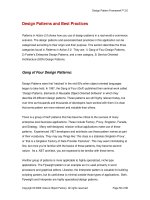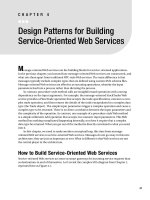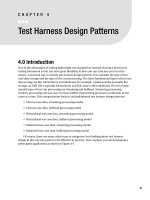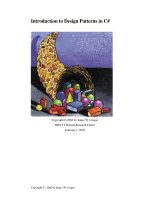Test Harness Design Patterns
Bạn đang xem bản rút gọn của tài liệu. Xem và tải ngay bản đầy đủ của tài liệu tại đây (287.72 KB, 36 trang )
Test Harness Design Patterns
4.0 Introduction
One of the advantages of writing lightweight test automation instead of using a third-party
testing framework is that you have great flexibility in how you can structure your test har-
nesses. A practical way to classify test harness design patterns is to consider the type of test
case data storage and the type of test-run processing. The three fundamental types of test case
data storage are flat, hierarchical, and relational. For example, a plain-text file is usually flat
storage; an XML file is typically hierarchical; and SQL data is often relational. The two funda-
mental types of test-run processing are streaming and buffered. Streaming processing
involves processing one test case at a time; buffered processing processes a collection of test
cases at a time. This categorization leads to six fundamental test harness design patterns:
• Flat test case data, streaming processing model
• Flat test case data, buffered processing model
• Hierarchical test case data, streaming processing model
• Hierarchical test case data, buffered processing model
• Relational test case data, streaming processing model
• Relational test case data, buffered processing model
Of course, there are many other ways to categorize, but thinking about test harness
design in this way has proven to be effective in practice. Now, suppose you are developing a
poker game application as shown in Figure 4-1.
97
CHAPTER 4
■ ■ ■
6633c04.qxd 4/3/06 1:56 PM Page 97
Figure 4-1. Poker Game AUT
Let’s assume that the poker application references a PokerLib.dll library that houses
classes to create and manipulate various poker objects. In particular, a Hand() constructor
accepts a string argument such as “Ah Kh Qh Jh Th” (ace of hearts through ten of hearts), and
a Hand.GetHandType() method returns an enumerated type with a string representation such
as “RoyalFlush”. As described in Chapter 1, you need to thoroughly test the methods in the
PokerLib.dll library. This chapter demonstrates how to test the poker library using each of the
six fundamental test harness design patterns and explains the advantages and disadvantages
of each pattern. For example, Section 4.3 uses this hierarchical test case data:
CHAPTER 4
■
TEST HARNESS DESIGN PATTERNS98
6633c04.qxd 4/3/06 1:56 PM Page 98
<?xml version="1.0" ?>
<testcases>
<case id="0001">
<input>Ac Ad Ah As Tc</input>
<expected>FourOfAKindAces</expected>
</case>
<case id="0002">
<input>4s 5s 6s 7s 3s</input>
<expected>StraightSevenHigh</expected>
</case>
<case id="0003">
<input>5d 5c Qh 5s Qd</input>
<expected>FullHouseFivesOverQueens</expected>
</case>
</testcases>
and uses a streaming processing model to produce this result:
<?xml version="1.0" encoding="utf-8"?>
<TestResults>
<case id="0001">
<result>Pass</result>
</case>
<case id="0002">
<input>4s 5s 6s 7s 3s</input>
<expected>StraightSevenHigh</expected>
<actual>StraightFlushSevenHigh</actual>
<result>*FAIL*</result>
</case>
<case id="0003">
<result>Pass</result>
</case>
</TestResults>
Although the techniques in this chapter demonstrate the six fundamental design patterns
by testing a .NET class library, the patterns are general and apply to testing any type of software
component.
The streaming processing model, expressed in pseudo-code, is
loop
read a single test case from external store
parse test case data into input(s) and expected(s)
call component under test
determine test case result
save test case result to external store
end loop
CHAPTER 4
■
TEST HARNESS DESIGN PATTERNS 99
6633c04.qxd 4/3/06 1:56 PM Page 99
The buffered processing model, expressed in pseudo-code, is
loop // 1. read all test cases
read a single test case from external store into memory
end loop
loop // 2. run all test cases
read a single test case from in-memory store
parse test case data into input(s) and expected(s)
call component under test
determine test case result
store test case result to in-memory store
end loop
loop // 3. save all results
save test case result from in-memory store to external store
end loop
The streaming processing model is simpler than the buffered model, so it is often your
best choice. However, in two common scenarios, you should consider using the buffered
processing model. First, if the aspect in the system under test (SUT) involves file input/out-
put, you often want to minimize test harness file operations. This is especially true if you are
monitoring performance. Second, if you need to perform any preprocessing of your test case
input (for example, pulling in and filtering test case data from more than one data store) or
postprocessing of your test case results (for example, aggregating various test case category
results), it’s almost always more convenient to have data in memory where you can process it.
4.1 Creating a Text File Data, Streaming Model
Test Harness
Problem
You want to create a test harness that uses text file test case data and a streaming processing
model.
Design
In one continuous processing loop, use a StreamReader object to read a test case data into
memory, then parse the test case data into input and expected values using the String.Split()
method, and call the component under test (CUT). Next, check the actual result with the
expected result to determine a test case pass or fail. Then, write the results to external storage
with a StreamWriter object. Do this for each test case.
CHAPTER 4
■
TEST HARNESS DESIGN PATTERNS100
6633c04.qxd 4/3/06 1:56 PM Page 100
Solution
Begin by creating a tagged and end-of-file delimited test case file:
[id]=0001
[input]=Ac Ad Ah As Tc
[expected]=FourOfAKindAces
[id]=0002
[input]=4s 5s 6s 7s 3s
[expected]=StraightSevenHigh
[id]=0003
[input]=5d 5c Qh 5s Qd
[expected]=FullHouseFivesOverQueens
*
Then process using StreamReader and StreamWriter objects:
Console.WriteLine("\nBegin Text File Streaming model test run\n");
FileStream ifs = new FileStream("..\\..\\..\\TestCases.txt",
FileMode.Open);
StreamReader sr = new StreamReader(ifs);
FileStream ofs = new FileStream("TextFileStreamingResults.txt",
FileMode.Create);
StreamWriter sw = new StreamWriter(ofs);
string id, input, expected, blank, actual;
while (sr.Peek() != '*')
{
id = sr.ReadLine().Split('=')[1];
input = sr.ReadLine().Split('=')[1];
expected = sr.ReadLine().Split('=')[1];
blank = sr.ReadLine();
string[] cards = input.Split(' ');
Hand h = new Hand(cards[0], cards[1], cards[2], cards[3], cards[4]);
actual = h.GetHandType().ToString();
sw.WriteLine("====================");
sw.WriteLine("ID = " + id);
sw.WriteLine("Input = " + input);
sw.WriteLine("Expected = " + expected);
sw.WriteLine("Actual = " + actual);
CHAPTER 4
■
TEST HARNESS DESIGN PATTERNS 101
6633c04.qxd 4/3/06 1:56 PM Page 101
if (actual == expected)
sw.WriteLine("Pass");
else
sw.WriteLine("*FAIL*");
}
sw.WriteLine("====================");
sr.Close(); ifs.Close();
sw.Close(); ofs.Close();
Console.WriteLine("\nDone");
Comments
You begin by creating a test case data file. As shown in the techniques in Chapter 1, you could
structure the file with each test case on one line:
0001:Ac Ad Ah As Tc:FourOfAKindAces
0002:4s 5s 6s 7s 3s:StraightSevenHigh:deliberate error
0003:5d 5c Qh 5s Qd:FullHouseFivesOverQueens
When using this approach, notice that the meaning of each part of the test case data is
implied (the first item is the case ID, the second is the input, and the third is the expected
result). A more flexible solution is to provide some structure to your test case data by adding
tags such as "[id]" and "[input]". This allows you to easily perform rudimentary validity
checks. For example:
string temp = sr.ReadLine(); // should be the ID
if (temp.StartsWith("[id]"))
id = temp.Split('=')[1];
else
throw new Exception("Invalid test case line");
You can perform validity checks on your test case data via a separate program that you
run before you run the test harness, or you can perform validity checks inside the test harness
itself. In addition to validity checks, structure tags also allow you to deal with test case data
that has a variable number of inputs.
This technique assumes that you have added a project reference to the PokerLib.dll library
under test and that you have supplied appropriate using statements so you don’t have to fully
qualify classes and objects:
using System;
using PokerLib;
using System.IO;
You should also always wrap your test harness code in try-catch-finally blocks:
CHAPTER 4
■
TEST HARNESS DESIGN PATTERNS102
6633c04.qxd 4/3/06 1:56 PM Page 102
static void Main(string[] args)
{
// Open any files here
try
{
// main harness code here
}
catch(Exception ex)
{
Console.WriteLine("Fatal error: " + ex.Message);
}
finally
{
// Close any open streams here
}
} // Main()
When the code in this section is run with the preceding test case input data, the output is
====================
ID = 0001
Input = Ac Ad Ah As Tc
Expected = FourOfAKindAces
Actual = FourOfAKindAces
Pass
====================
ID = 0002
Input = 4s 5s 6s 7s 3s
Expected = StraightSevenHigh
Actual = StraightFlushSevenHigh
*FAIL*
====================
ID = 0003
Input = 5d 5c Qh 5s Qd
Expected = FullHouseFivesOverQueens
Actual = FullHouseFivesOverQueens
Pass
====================
Test case #0002 is an intentional failure. Using a special character token in the test case
data file to signal end-of-file is an old but effective technique. With such a token in place, you
can use the StreamReader.Peek() method to check the next input character without actually
consuming it from the associated stream.
To create meaningful test cases, you must understand how the SUT works. This can be dif-
ficult. Techniques to discover information about the SUT are discussed in Section 4.8. This
solution represents a minimal test harness. You can extend the harness, for example, by adding
CHAPTER 4
■
TEST HARNESS DESIGN PATTERNS 103
6633c04.qxd 4/3/06 1:56 PM Page 103
summary counters of the number of test cases that pass and the number that fail by using the
techniques in Chapter 1.
4.2 Creating a Text File Data, Buffered Model Test
Harness
Problem
You want to create a test harness that uses text file test case data and a buffered processing
model.
Design
Read all test case data into an ArrayList collection that holds lightweight TestCase objects.
Then iterate through the test cases ArrayList object, executing each test case and storing the
results into a second ArrayList object that holds lightweight TestCaseResult objects. Finally,
iterate through the results ArrayList object, saving the results to an external text file.
Solution
Begin by creating lightweight TestCase and TestCaseResult classes:
class TestCase
{
public string id;
public string input;
public string expected;
public TestCase(string id, string input, string expected)
{
this.id = id;
this.input = input;
this.expected = expected;
}
} // class TestCase
class TestCaseResult
{
public string id;
public string input;
public string expected;
public string actual;
public string result;
CHAPTER 4
■
TEST HARNESS DESIGN PATTERNS104
6633c04.qxd 4/3/06 1:56 PM Page 104
public TestCaseResult(string id, string input, string expected,
string actual, string result)
{
this.id = id;
this.input = input;
this.expected = expected;
this.actual = actual;
this.result = result;
}
} // class TestCaseResult
Notice these class definitions use public data fields for simplicity. A reasonable alternative
is to use a C# struct type instead of a class type. The data fields for the TestCase class should
match the test case input data. The data fields for the TestCaseResult class should generally
contain most of the fields in the TestCase class, the fields for the actual result of calling the CUT,
and the test case pass or fail result. Because of this, a design option for you to consider is plac-
ing a reference to a TestCase object in the definition of the TestCaseResult class. For example:
class TestCaseResult
{
public TestCase tc;
public string actual;
public string result;
public TestCaseResult(TestCase tc, string actual, string result)
{
this.tc = tc;
this.actual = actual;
this.result = result;
}
} // class TestCaseResult
You may also want to include fields for the date and time when the test case was run. You
process the test case data using three loop control structures and two ArrayList objects like
this:
Console.WriteLine("\nBegin Text File Buffered model test run\n");
FileStream ifs = new FileStream("..\\..\\..\\TestCases.txt",
FileMode.Open);
StreamReader sr = new StreamReader(ifs);
FileStream ofs = new FileStream("TextFileBufferedResults.txt",
FileMode.Create);
StreamWriter sw = new StreamWriter(ofs);
string id, input, expected = "", blank, actual;
TestCase tc = null;
TestCaseResult r = null;
CHAPTER 4
■
TEST HARNESS DESIGN PATTERNS 105
6633c04.qxd 4/3/06 1:56 PM Page 105
// 1. read all test case data into memory
ArrayList tcd = new ArrayList(); // test case data
while (sr.Peek() != '*')
{
id = sr.ReadLine().Split('=')[1];
input = sr.ReadLine().Split('=')[1];
expected = sr.ReadLine().Split('=')[1];
blank = sr.ReadLine();
tc = new TestCase(id, input, expected);
tcd.Add(tc);
}
sr.Close(); ifs.Close();
// 2. run all tests, store results to memory
ArrayList tcr = new ArrayList(); // test case result
for (int i = 0; i < tcd.Count; ++i)
{
tc = (TestCase)tcd[i];
string[] cards = tc.input.Split(' ');
Hand h = new Hand(cards[0], cards[1], cards[2], cards[3], cards[4]);
actual = h.GetHandType().ToString();
if (actual == tc.expected)
r = new TestCaseResult(tc.id, tc.input, tc.expected,
actual, "Pass");
else
r = new TestCaseResult(tc.id, tc.input, tc.expected,
actual, "*FAIL*");
tcr.Add(r);
} // main processing loop
// 3. emit all results to external storage
for (int i = 0; i < tcr.Count; ++i)
{
r = (TestCaseResult)tcr[i];
sw.WriteLine("====================");
sw.WriteLine("ID = " + r.id);
sw.WriteLine("Input = " + r.input);
sw.WriteLine("Expected = " + r.expected);
sw.WriteLine("Actual = " + r.actual);
sw.WriteLine(r.result);
}
sw.WriteLine("====================");
sw.Close(); ofs.Close();
Console.WriteLine("\nDone");
CHAPTER 4
■
TEST HARNESS DESIGN PATTERNS106
6633c04.qxd 4/3/06 1:56 PM Page 106
Comments
The buffered processing model has three distinct phases. First, you read all test case data into
memory. Although you can do this in many ways, experience has shown that your harness will
be much easier to maintain if you create a very lightweight class for the test case data. Don’t
get carried away and try to make a universal test case class that can accommodate any kind of
test case input, however, because you’ll end up with a class that is so general it’s too awkward
to use effectively.
You have many choices of the kind of data structure to store your TestCase objects into.
A System.Collections.ArrayList object is simple and effective. Because test case data is
processed strictly sequentially in some situations, you may want to consider using a Stack
or a Queue collection.
In the second phase of the buffered processing model, you iterate through each test case in
the ArrayList object that holds TestCase objects. After retrieving the current TestCase object,
you execute the test and determine a result. Then you instantiate a new TestCaseResult object
and add it to the ArrayList that holds TestCaseResult objects. Although it’s not a major issue,
you do need to take some care to avoid confusing your objects. Notice that you’ll have two
ArrayList objects, a TestCase object and a TestCaseResult object, both of which contain a test
case ID, test case input, and expected result.
In the third phase of the buffered processing model, you iterate through each test case
result in the result ArrayList object and write information to an external text file. Of course,
you can also easily emit results to an XML file, SQL database, or other external storage. If you
run this code with the test case data file from Section 4.1
[id]=0001
[input]=Ac Ad Ah As Tc
[expected]=FourOfAKindAces
etc.
you will get the identical output as in Section 4.1:
====================
ID = 0001
Input = Ac Ad Ah As Tc
Expected = FourOfAKindAces
Actual = FourOfAKindAces
Pass
====================
etc.
You can modularize this technique by writing three helper methods that wrap the code in
the section. With these helper methods, your harness might look like:
CHAPTER 4
■
TEST HARNESS DESIGN PATTERNS 107
6633c04.qxd 4/3/06 1:56 PM Page 107
class Class1
{
static void Main(string[] args)
{
ArrayList tcd = null; // test case data
ArrayList tcr = null; // test case results
tcd = ReadData("..\\TestCases.txt");
tcr = RunTests(tcd);
SaveResults(tcr, "..\\TestResults.txt");
}
static ArrayList ReadData(string file)
{
// code here
}
static ArrayList RunTests(ArrayList testdata)
{
// code here
}
static void SaveResults(ArayList results, string file)
{
// code here
}
}
class TestCase
{
// code here
}
class TestCaseResult
{
// code here
}
4.3 Creating an XML File Data, Streaming Model
Test Harness
Problem
You want to create a test harness that uses XML file test case data and a streaming processing
model.
Design
In one continuous processing loop, use an XmlTextReader object to read a test case into mem-
ory, then parse the test case data into input and expected values using the GetAttribute() and
ReadElementString() methods, and call the CUT. Next, check the actual result with the
CHAPTER 4
■
TEST HARNESS DESIGN PATTERNS108
6633c04.qxd 4/3/06 1:56 PM Page 108
expected result to determine a test case pass or fail. Then, write the results to external storage
using an XmlTextWriter object. Do this for each test case.
Solution
Begin by creating an XML test case file:
<?xml version="1.0" ?>
<testcases>
<case id="0001">
<input>Ac Ad Ah As Tc</input>
<expected>FourOfAKindAces</expected>
</case>
<case id="0002">
<input>4s 5s 6s 7s 3s</input>
<expected>StraightSevenHigh</expected>
</case>
<case id="0003">
<input>5d 5c Qh 5s Qd</input>
<expected>FullHouseFivesOverQueens</expected>
</case>
</testcases>
Then process the test case data using XmlTextReader and XmlTextWriter objects:
Console.WriteLine("\nBegin XML File Streaming model test run\n");
XmlTextReader xtr = new XmlTextReader("..\\..\\..\\TestCases.xml");
xtr.WhitespaceHandling = WhitespaceHandling.None;
XmlTextWriter xtw = new XmlTextWriter("XMLFileStreamingResults.xml",
System.Text.Encoding.UTF8);
xtw.Formatting = Formatting.Indented;
string id, input, expected, actual;
xtw.WriteStartDocument();
xtw.WriteStartElement("TestResults"); // root node
while (!xtr.EOF) // main loop
{
if (xtr.Name == "testcases" && !xtr.IsStartElement())
break;
while (xtr.Name != "case" || !xtr.IsStartElement())
xtr.Read(); // go to a <case> element if not there yet
CHAPTER 4
■
TEST HARNESS DESIGN PATTERNS 109
6633c04.qxd 4/3/06 1:56 PM Page 109
id = xtr.GetAttribute("id");
xtr.Read(); // advance to <input>
input = xtr.ReadElementString("input"); // go to <expected>
expected = xtr.ReadElementString("expected"); // go to </case>
xtr.Read(); // go to next <case> or </testcases>
string[] cards = input.Split(' ');
Hand h = new Hand(cards[0], cards[1], cards[2], cards[3], cards[4]);
actual = h.GetHandType().ToString();
xtw.WriteStartElement("case");
xtw.WriteStartAttribute("id", null);
xtw.WriteString(id); xtw.WriteEndAttribute();
xtw.WriteStartElement("input");
xtw.WriteString(input); xtw.WriteEndElement();
xtw.WriteStartElement("expected");
xtw.WriteString(expected); xtw.WriteEndElement();
xtw.WriteStartElement("actual");
xtw.WriteString(actual); xtw.WriteEndElement();
xtw.WriteStartElement("result");
if (actual == expected)
xtw.WriteString("Pass");
else
xtw.WriteString("*FAIL*");
xtw.WriteEndElement(); // </result>
xtw.WriteEndElement(); // </case>
} // main loop
xtw.WriteEndElement(); // </TestResults>
xtr.Close();
xtw.Close();
Console.WriteLine("\nDone");
The XmlTextReader.Read() method advances one XML node at a time through the XML
file. Because XML is hierarchical, keeping track of exactly where you are within the file is a bit
tricky. To write results, you use an XmlTextWriter object with the WriteStartElement(), the
WriteString(), and the WriteEndElement() methods, along with the WriteStartAttribute()
and WriteEndAttribute() methods.
CHAPTER 4
■
TEST HARNESS DESIGN PATTERNS110
6633c04.qxd 4/3/06 1:56 PM Page 110









